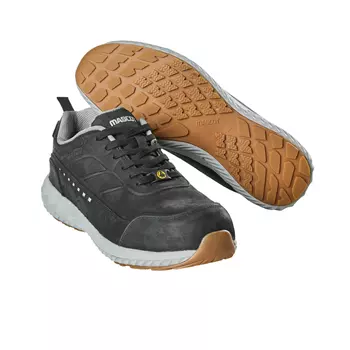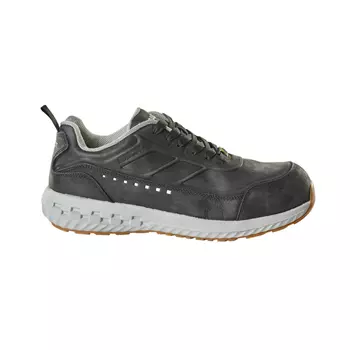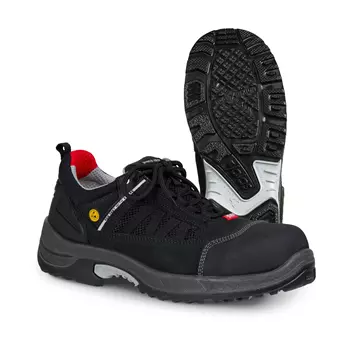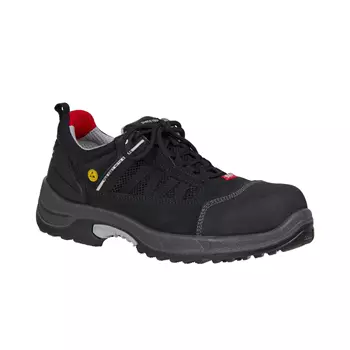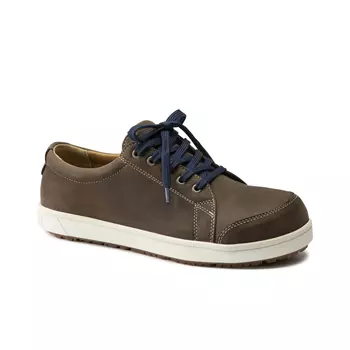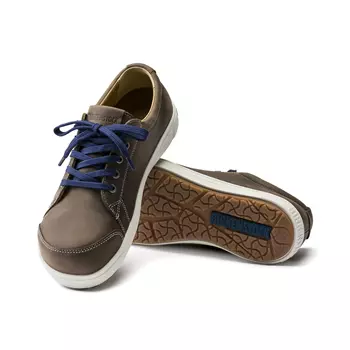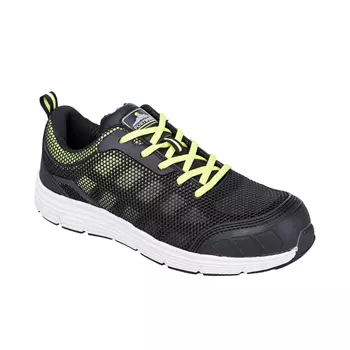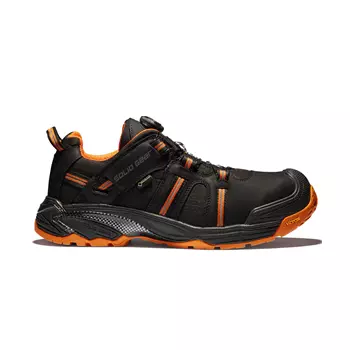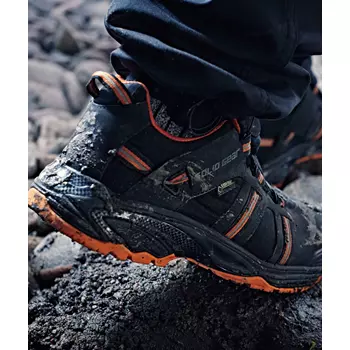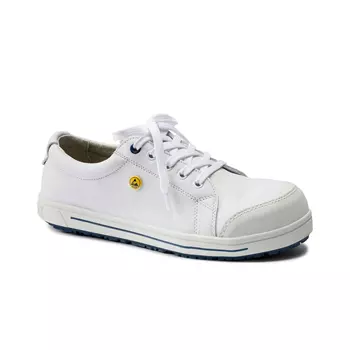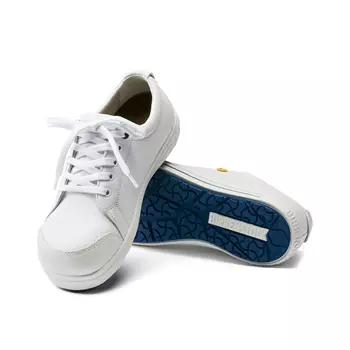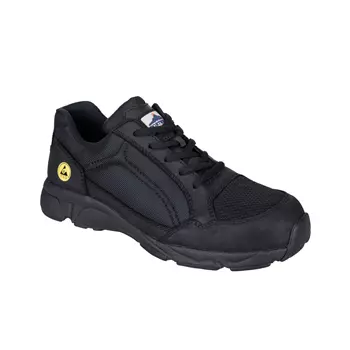Guide to safety shoes and safety boots
Should I choose safety shoes with toe caps and penetration protection?
Choosing safety footwear can be a bit of a challenge, as there are many things to consider when looking for safe footwear or protective footwear for work. Many workplaces set specific safety class requirements for the safety shoes or safety boots that their employees must order and wear for work. Are you curious about the meaning of terms such as S1, S2, S3, S4, S5, S6, S7 and other markings? Do you want general information about what the different abbreviations mean, and an understanding of how well your feet will be protected? Then you’ll find the answers in this guide.
Safety footwear is certified according to the European standard for safety footwear, EN ISO 20345. Then it can say 2011 or 2022. 2011 expires in 2028, and 2022 continues. LG, which means ladder grip, is a new approval on EN20345: 2022. Footwear certified according to this standard has toecap with the minimum protection, against falling items of 200 joules (J) and against compression of 15 kiloNewtons (kn). This basic safety shoe approval is called SB. All safety shoes, regardless of brand, are tested in the same way, and the method is EU regulated. The standard is called EN ISO 20347 and EN ISO 20345. After testing, the footwear will be CE marked, which is your guarantee that the product complies with EU legislation. All safety footwear on Cheap-workwear.com is of course CE-approved.
Read further down the page to learn more about other approvals.
Safety shoes with toe caps protect your toes
The toe cap, or toe guard as it is also called, prevents the shoes from “caving in". This means that if something heavy falls on your toes, the toe cap will not collapse, helping to protect your toes from injury. Below, you can see the types of toe caps you can choose.
A steel toe cap has the advantage of being strong and thin. It does not take up much space in safety footwear. A steel toe cap can feel cold if you work in very cold conditions. You’ll find safety footwear with steel toe protection here.
An aluminium toe guard is 50 % lighter than steel.It is thin and has the same properties as steel. Find safety footwear with aluminium toe guards here.
- A toe cap in fibre, fibreglass or composite is light and 100 % metal-free. Fibre and composite insulate against cold and heat. Safety footwear with fibre / composite toe protection can be found here.
Penetration protection shields feet if you step on nails and sharp objects
Penetration protection prevents sharp and pointed objects from penetrating the sole and injuring your feet. They can be made from steel, wood and fibre / composite, and they meet the same requirements. Find safety footwear with penetration protection here.
- Steel nail guards are strong, and suitable if you run the risk of stepping on small, sharp objects.
- Nail protection in fibre is flexible and metal-free, and does not transport cold.
- Wooden nail guards are used in clogs, and are well suited for stationary work. Wood is cold insulating.
Non-slip safety shoes protect against falls
If you walk on slippery floors where liquids such as water, blood or oil may be spilled, then you must wear non-slip safety shoes. There are SRA, SRB, and SRC slip-tested safety shoes, collectively known as SR, and below you can see the difference.
- SRA means that the outsole has passed a step test on a ceramic tile with soap solution (sodium lauryl sulphate). Find safety footwear with SRA-approved outsoles here.
- SRB means that the outsole has passed a step test on a steel plate with glycerine. Safety footwear with SRB-approved outsoles can be found here.
- SRC means that the outsole has passed both the SRA and SRB step tests. Take a look at safety footwear with SRC-approved outsoles here.
ESD safety shoes discharge static electricity
All approved safety shoes have antistatic properties. ESD provides extra antistatic characteristics, and constantly dissipates static electricity evenly through the sole in a controlled and safe way. ESD-approved safety shoes and safety boots can prevent you from damaging sensitive electronic components and equipment.
Please note that a shoe is approved as a whole. If you choose to put another insole in the shoes, they will no longer be ESD-approved. The ESD function can be affected in other ways; for example, thick wool socks can reduce the shoes’ current-conducting ability. Therefore, you should use ESD-approved socks in your ESD-approved shoes, to take full advantage of the shoes' antistatic properties. Find ESD-approved safety footwear here.
EN ISO 20345:2022 |
Safety footwear |
Waterproof boots |
Safety footwear |
||||||||||||||
| Safety classes | SB | S1 | S1P | S1PL | S1PS | S2 | S3 | S3L | S3S | S4 | S5 | S5L | S5S | S6 | S7 | S7L | S7P |
| SB | √ | √ | √ | √ | √ | √ | √ | √ | √ | √ | √ | √ | √ | √ | √ | √ | √ |
| P | X | X | √ | X | X | X | √ | X | X | X | √ | X | X | X | √ | X | X |
| PL | X | X | X | √ | X | X | X | √ | X | X | X | √ | X | X | X | √ | X |
| PS | X | X | X | X | √ | X | X | X | √ | X | X | X | √ | X | X | X | √ |
| WPA | X | X | X | X | X | √ | √ | √ | √ | - | - | - | - | X | X | X | X |
| WR | X | X | X | X | X | X | X | X | X | - | - | - | - | √ | √ | √ | √ |
| E | X | √ | √ | √ | √ | √ | √ | √ | √ | √ | √ | √ | √ | √ | √ | √ | √ |
| A | X | √ | √ | √ | √ | √ | √ | √ | √ | √ | √ | √ | √ | √ | √ | √ | √ |
| Profiled outsole | X | X | X | X | X | X | √ | √ | √ | X | √ | √ | √ | X | √ | √ | √ |
T: Toe protection. Protects the toes against falling objects på 200 Joule and of at least 200 J (joule) and against crushing (at least 15 kN, kiloNewton)
P: Penetration protection. Prevents sharp objects from penetrating the sole
SR: The outsole has been tested on ceramic tile wetted with a glycerin solution
SRA: Non-slip properties. The outsole has been tested on ceramic tile wetted with a soap solution
SRB: non-slip properties. The outsole has been tested on steel with glycerol
SRC: Non-slip properties. The outsole has been tested under SRA and SRB conditions
ESD. Diverts static electricity through the sole in a controlled and safe manner. The requirements are according to standard EN 61340-4-3 ≥ 0,1MΩ > 100MΩ and EN 61340-5-1 ≥ 0,1MΩ > 35MΩ
HRO: Tested and approved for contact heat up to 300 °C for 1 minute
HI: Insulated against heat
CI: Insulated against cold
WR: Water-resistant
FO: Oil and petrol-resistant outsole
ProNose (SC). Is an extra toe reinforcement of the upper or rubber cap affixed to the shoe that makes the footwear suitable for work involving kneeling, as it reduces direct wear on the toe
LG: Ladder grip
Below you can see our selection of men’s and women’s safety shoes. Remember that we also have safety sandals, safety dealer boots, and safety boots.
Questions about choosing safety footwear?
If you are in doubt about what best suits your needs, you are always welcome to contact our customer service.
You can contact our customer service at info@cheap-workwear.com or on tel. 9674 2030.
They will be ready with suggestions to help you find just what you are looking for.















